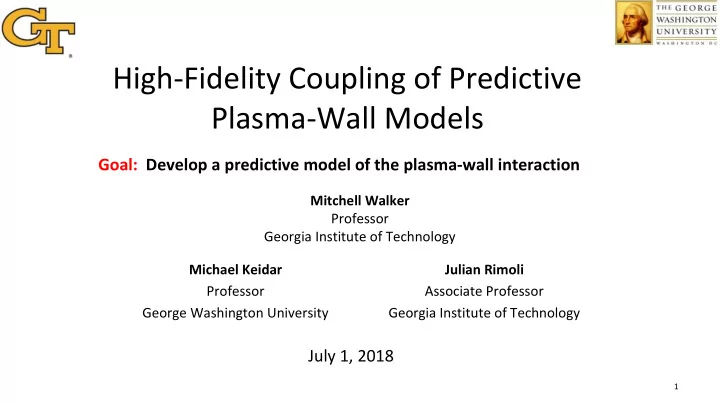

High-Fidelity Coupling of Predictive Plasma-Wall Models Goal: Develop a predictive model of the plasma-wall interaction Mitchell Walker Professor Georgia Institute of Technology Michael Keidar Julian Rimoli Professor Associate Professor George Washington University Georgia Institute of Technology July 1, 2018 1
Erosion Prediction: Algorithm and Program Model Results The model is based on the probability of the Joint probability of erosion surface of being eroded. Surface evolution The Probability of material removal function depends on: ü Mechanical damage ü Ion energy deposition Ion energy deposition is interpolated M e c using the “front” and the “groove” data as h a n i c a a function of the visibility and the size l n d o i a t s i m o p e factor of the surface ripples a d y g g e r e n e n o I Ion energy deposition to wall Energy bounds from plasma models Size factor visibility I. Schweigert, "2018 Plasma Sources Sci. Technol. 27 045004
Plasma Modeling: Non-uniformity of ion flux distribution over segmented surface Task: Model the ion current profile near plane BN surface with segments of material with low secondary electron emission (SEE). Model: Boltzmann eqns for electron and ion distribution functions, Poisson eqn for electrical potential. Emissive floating a) plane segmented or b) grooved BN plates is 28 cm from the cathode. ( 2D PIC MCC with code PlasmaNov.) For comparison: Potential over grooved Segmented surface: Potential distribution Segmented surface: Potential distribution surface, white lines show electron before and after transition : U= - 150 V before and after transition : U= - 190 V trajectories Conclusions: For segmented surface (BN Segmented surface: surface with low SEE insert) as well as for Ion current density grooved surface, the near-surface potential is profile over z for U=-150 V (blue) non-monotonic. It redistributes ions current over x for inside of grooves. Etching rate of at low SEE U=-190 V (red). segments and inside of grooves has higher rate that at front BN surface.
Impact of Cracks on the Erosion Proposed mechanism: Expansion/compression of BN into the surrounding silica matrix during thermal cycles Impact on erosion process: Preferential sputtering of BN compared to silica in regions of high plasma flux Quantify the effect of thermal cycling on crack formation in anisotropic material (M26 borosil) 1. What size cracks can be formed by thermal shock of M26 borosil? Can the cracks grow beyond the grain boundaries? 2. Are stresses from thermal cycling solely responsible for the microcracks? Step 1: Develop diagnostic Step 2: Software for crack identification Initial: 3D height maps taken after 30 thermal cycles at 100x magnification with confocal microscope. No cracks detected – now moving to SEM for microcrack detection SEM image of unpolished borosil First high-res SEM images taken of borosil Future: Does the presence of without prior coating Flood-fill algorithm to identify crack boundaries from cracks play a role in the plasma (collaboration with SEM experts) a single user click in the interior of a crack erosion process?
Recommend
More recommend